 полная версия
полная версияStories of Useful Inventions
But even the excellent American cradle-scythe could not meet the needs of the American farmer. The cast iron plow which was brought into use in the early part of the nineteenth century (p. 82) made it possible to raise fields of wheat vastly larger than had ever been raised before. But it was of no use to raise great fields of grain unless the crop could be properly harvested. Wheat must be cut just when it is ripe and the harvest season lasts only a few days. If the broad American fields were to be plowed and planted there would have to be a reaping machine that would cut the grain faster than human hands could cut it with the scythe (Fig. 6).

FIG. 7. – THE FIRST REAPING MACHINE, 70 A. D.
So about the year 1800 inventors in Europe and in America took up the task of inventing a new kind of reaper. The first attempts were made in England where population was increasing very fast and where large quantities of grain were needed to feed the people. The first hints for a reaper were from a machine which was used in Gaul nearly 2,000 years ago. Pliny, who described for us a wonderful plow used in his time (p. 77), also describes this ancient reaper of the Gauls. It consisted of a large hollow frame mounted on two wheels (Fig. 7). At the front of the frame there was a set of teeth which caught the heads of grain and tore them off. The heads were raked into the box by an attendant. The machine was pushed along by an ox. This kind of machine was doubtless used in Europe for a while but it was not a success. It passed out of use and for many centuries it was entirely forgotten. Still, the first English reaping machines were made after the plan of this interesting old reaper of ancient Gaul.
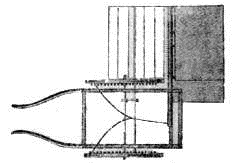
FIG. 8. – OGLE'S REAPER, 1822.
The most remarkable of the early reapers was one invented by Henry Ogle, a schoolmaster of Remington, England. In 1822 Ogle constructed a model for a reaper which was quite different from any that had appeared before and which bore a close resemblance to the improved reapers of a later date. In Ogle's reaper (Fig. 8) the horse walked ahead beside the standing grain, just as it does now, and the cutting apparatus was at the right, just as it is now. The cutter consisted of a frame at the front of which was a bar of iron armed with a row of teeth projecting forward. Directly under the teeth lay a long straight edged knife which was moved to and fro by means of a crank and which cut the grain as it came between the teeth. A reel pushed the grain toward the knife and there was a platform upon which the grain when cut might fall. Ogle's machine did not meet with much success yet it holds a very high place in the history of reaping machines, for it had nearly all the parts of a modern reaper.
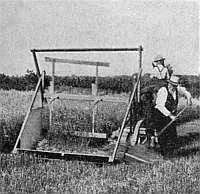
FIG. 9. – THE FIRST MCCORMICK REAPER.
English inventors did much to prepare the way for a good reaping machine but the first really successful reaper, the first reaper that actually reaped, was made in the United States. In the summer of 1831, Cyrus McCormick, a young blacksmith living in the Shenandoah Valley in Virginia, made a trial of a reaper which he and his father had invented – how much they had learned from Ogle we do not know – and the trial was successful (Fig. 9). With two horses he cut six acres of oats in an afternoon. "Such a thing," says Mr. Casson in his life of McCormick, "at the time was incredible. It was equal to the work of six laborers with scythes or twenty-four peasants with sickles. It was as marvelous as though a man had walked down the street carrying a dray horse on his back."
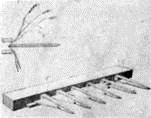
FIG. 10. – THE KNIFE BLADE OF HUSSEY'S REAPER.
Although McCormick had his reaper in successful operation by 1831 he did not take out a patent for the machine until 1834. One year before this (in 1833) Obed Hussey, a sailor living in Baltimore, took out a patent for a reaper that was successful and that was in many respects as famous a machine as McCormick's. So while McCormick was the first in the field with his invention, Hussey was the first to secure a patent. The machines of McCormick and Hussey were very much alike: both had the platform, the iron bar armed with guards and the long knife moving to and fro. The most remarkable feature of Hussey's machine was the knife which consisted of thin triangular plates of steel sharpened on two edges and riveted side by side upon a flat bar (Fig. 10). The saw-like teeth of Hussey's knife caught the wheat between the guards and cut it better than any knife that had as yet appeared. Both the McCormick reapers and the Hussey reapers were practical and successful and each of these inventors performed a noble part in giving the world the reaper it needed.
The McCormick and the Hussey reapers gave new life to farming in the United States. Especially was the reaper a blessing to the Western farmers. In 1844 McCormick took a trip through the West, passing through Ohio, Michigan, Illinois, and Iowa. As he passed through Illinois he saw how badly the reaper was needed. He saw great fields of ripe wheat thrown open to be devoured by hogs and cattle because there were not enough laborers to harvest the crops. The farmers had worked day and night and their wives and children had worked but they could not harvest the grain; they had raised more than the scythe and sickle could cut. McCormick saw that the West was the natural home for the reaper and in 1847 he moved to Chicago, built a factory, and began to make reapers. In less than a year he had orders for 500 machines and before ten years had passed he had sold nearly 25,000 reapers. It was these reapers that caused the frontier line to move westward at the rate of thirty miles a year.
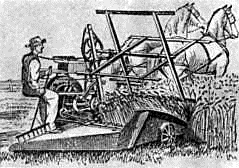
FIG. 11. – REAPER PROVIDED WITH SEAT FOR THE RAKER.
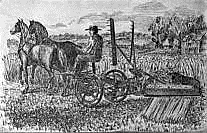
FIG. 12. – SELF-RAKING REAPER.
Improvements upon the machines of Hussey and McCormick came thick and fast. One of the first improvements was to remove the grain from the platform in a better way. With the first machines a man followed the reaper (Fig. 9) and removed the grain with a rake. Then a seat was provided and the man sat (Fig. 11) on the reaper and raked off the grain. Finally the self-raking reaper was invented. In this machine, as it appeared in its completed form about 1865, the reel and rake were combined. The reel consisted of a number of revolving arms each of which carried a rake (Fig. 12). As the arms revolved they not only moved the standing grain toward the knife, but they also swept the platform and raked off the wheat in neat bunches ready to be bound into sheaves. So the self-raking reaper saved the labor of the man who raked the wheat from the platform.

FIG. 13. – A SELF-BINDING REAPER.
Because it saved the labor of one man the self-raking reaper was for a time the king of reaping machines. But it did not remain king long, for soon there came into the harvest fields a reaper that saved the labor of several men. This was the self-binder. With the older machines, as the grain was raked off the platform it was gathered and bound into sheaves by men who followed the reaper, one reaper requiring the services of three or four or five human binders. With the self-binder (Fig. 13) the grain was gathered into sheaves and neatly tied without the aid of human hands. At first, wire was used in binding the sheaves but by 1880 most self-binders were using twine. So the self-binder saved the labor not only of the man who raked the grain from the platform but it saved the labor of all the binders as well.
The last step in the development of the reaper was taken when the complete harvester was invented. This machine cuts the standing grain, threshes it, winnows13 it, and places it in sacks (Fig. 14). As this giant reaper travels over the field one sees on one side the cutting bar 15 to 25 feet in length slicing its way through the wheat, while on the other side of the machine streams of grain run into sacks which, as fast as they are filled, are hauled to the barn or to the nearest railway station. The complete harvester is either drawn by horses – 30 or 40 in number – or by a powerful engine. It cuts and threshes 100 acres of wheat in a day and the cost is less than 50 cents an acre. It does as much work in a day as could have been done by a hundred men before the days of McCormick. Of all the wonderful machines used by farmers the most wonderful is the complete harvester, the latest and the greatest of reapers.
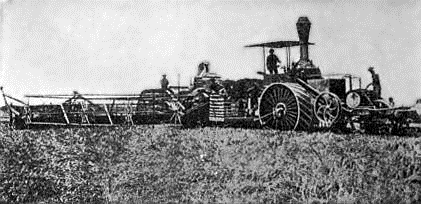
FIG. 14. – A COMBINED HARVESTER AND THRESHER.
THE MILL

FIG. 1. – THE FIRST MILL.
The first mill was a hole made in a stationary rock (Fig. 1). The grain was placed in the hole and crushed with a stone held in the hand. On Centre street in Trenton, New Jersey, not many years ago one of these primitive mills could still be seen and there are evidences that such mills once existed in all parts of the world. In those places where the earth did not supply the stationary rock, stones were brought from afar and hollowed out into cup-like form and in these the grinding was done.

FIG. 2. – THE KNOCKING-STANE.
The mill which consisted of a hole in a rock and a stone in the hands was followed by the "knocking-stane" and mallet (Fig. 2). The "knocking-stane" was a mortar, or cup-shaped vessel made of stone; the mallet was usually made of wood. The grain was placed in the mortar and struck repeatedly with the mallet, the beating being kept up until a coarse flour was produced. This is an exceedingly rude method of crushing grain, yet this is the way the people in some parts of Scotland grind their barley at the present time.

FIG. 3. – MORTAR AND PESTLE MILL.
At a very early date the "knocking-stane" was laid aside for the mortar and pestle (Fig. 3) almost everywhere. In this mill the grain instead of being struck with a hammer was pounded with a pestle. The bottom of the pestle was frequently covered with iron in which grooves were cut. As the man pounded he found that when he gave the pestle a twirling or rotary motion as it fell it ground the grain much faster. We may be sure that after this was learned the twirling motion was always given.
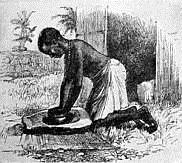
FIG. 4. – THE SLAB-MILL.
The mortar and pestle were followed by the slab-mill (Fig. 4). Here the grain was ground by being rubbed between two stones. Dr. Livingstone, the great African explorer, gives the following description of a slab-mill which he saw in operation in South Africa. "The operator kneeling grasps the upper millstone with both hands and works it backwards and forwards in the hollow of the lower millstone, in the same way that a baker works his dough. The weight of the person is brought to bear on the movable stone and while it is pressed and pushed forward and backward one hand supplies every now and then a little grain to be bruised and ground."

FIG. 5. – THE UPPER AND NETHER MILLSTONE.
As we have seen, the primitive miller gradually learned that the pestle did better work when it fell with a twirling motion. This little bit of experience led to important results in the development of the mill. If the grinding were done better with a twirling motion, why not have as much of the twirling motion as possible? Why not make the upper stone go round and round? This was what was done. The upper stone was caused to turn round and round. The wheel-mill, the mill of the upper and nether millstone (Fig. 5), was invented. When and where it was invented we cannot tell for it was in use among all civilized peoples before history began to be written. There were many kinds of wheel-mills among the nations of antiquity and in principle they were all alike in construction. How they worked may be learned by studying Figure 5 which represents a mill used in ancient India. The upper stone is placed upon the pivot projecting from the center of the lower (nether) stone, and caused to revolve by means of the handle. The grain when placed in the hollow at the center of the upper stone (Fig. 5) works its way down between the stones and comes out at the circumference ground, bran and flour together. The mill was fed with grain by the operator. The first hopper was a human hand.

FIG. 6. – AN ANCIENT JEWISH MILL.
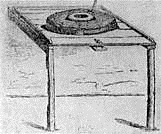
FIG. 8. – A SCOTTISH QUERN.

FIG. 7. – AN OLD ROMAN MILL.

FIG. 9. – POMPEIAN FLOUR MILL, 79 A. D.

FIG. 10. – SHOWING THE INTERIOR OF POMPEIAN MILL.
We have here several pictures of ancient mills. Figure 6 is an ancient Jewish mill. As we look at it we may recall the words, "Two women shall be grinding at a mill, the one shall be taken, and the other left."14 Figure 7 is an old Roman mill bearing a strong resemblance to the coffee mill that is used in our kitchens. Figure 8 is a Scottish quern, a mill that may still be found in use, it is said, in some parts of Scotland. Figure 9 is an old flour mill dug from the ruins of the city of Pompeii which was destroyed by an eruption in the year 79 A. D. Figure 10 shows the construction of this interesting mill. The upper (outer) stone is shaped like an hour-glass, the upper half of which serves as a hopper; the lower half turns upon the cone-shaped lower stone and does the grinding. The mill was operated by the projecting handles, the operators walking round and round the mill. Sometimes it was turned by human power, sometimes by horses or oxen.
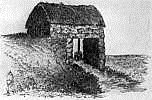
FIG. 11. – THE FIRST WATER-MILL, 50 B. C.
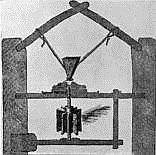
FIG. 12. – SHOWING THE INTERIOR OF THE FIRST WATER-MILL.
The Pompeian mill shows that as early as the first century the Romans ground their grain by animal power. Indeed about this time a still greater change was made in the method of grinding grain. When Julius Cæsar flourished (50 B. C.) men began to harness the power of running water and make it turn their mills (Fig. 11). From Figure 12 we may easily learn how this was done. The running water turns the wheel and in doing so turns the upper millstone. A hopper is suspended from the roof by ropes. Through this the grain passes into the mill. Here was a great saving in human labor and a great advancement in mill making. A Roman writer of Cæsar's time appreciating how great a blessing was the invention of the water-mill exclaimed:
Ye maids who toiled so faithful at the millNow cease from work and from these toils be still;Sleep now till dawn and let the birds with gleeSing to the ruddy morn, on bush and tree;For what your hands performed so long, so true,Ceres15 has charged the water-nymphs to do;They come, the limpid sisters, to her call,And on the wheel with dashing fury fall;Impel the axle with a whirling soundAnd make the massive millstone reel aroundAnd bring the floury heap luxuriant to the ground.Nothing can be simpler than the water-mill described above; it was the old mill of the upper and nether millstones, the old hand mill turned by water. That was all. Yet, as simple as it was, many centuries passed after its invention before a new principle in flour making was discovered. There were inventions for lowering and raising the stone so as to grind finer or coarser as might be desired, and there were improvements in the kind of water wheels employed, and better methods of sifting the flour from the bran were discovered from time to time, but the water-mill invented in the time of Julius Cæsar remained practically unchanged until the early part of the nineteenth century, when the last step in the development of the mill was taken.16
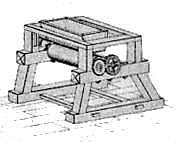
FIG. 13. – AN EARLY FLOUR ROLLER-MILL.
About 1810 millers in Austria, more particularly those in Vienna, began to grind their grain by passing it between two horizontal rollers (Fig. 13). The rollers were spirally grooved and turned toward each other. There was a wide difference between this process and the one to which the world was accustomed, yet the new method was found to be better than the old one. Austrian flour and Austrian bread became famous. The delicious Vienna bread on our tables of course has never seen Vienna. It is called "Vienna bread" because it is made out of a kind of flour which was first ground in the Austrian capital. The Austrian way of grinding grew rapidly into favor among millers everywhere. In the United States where there was so much wheat to be ground the roller process was taken up eagerly and improved upon as only Americans know how to improve upon an idea. In the flour mills of the West the grain was soon passing through a series of rollers. By the first pair of rollers the grain was simply cracked into pieces somewhat coarse. Then after being bolted (sifted) it was passed between a second pair of rollers and reduced to a greater fineness. Then it was bolted again and passed between a third pair of rollers. The rolling and sifting continued until a practically pure flour was obtained. A pure flour is the modern miller's ideal. He wants a branless flour and a flourless bran. The old stone mill could not grind this kind of flour. Before the roller mill appeared there was always bran in the flour and flour in the bran.
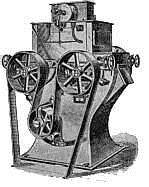
FIG. 14. – A MODERN FLOUR ROLLER-MILL.
The invention of the flour roller-mill (Fig. 14) is the last step in the development of the mill. The roller process has almost entirely driven out all other processes. Now and then we see by the roadside an old fashioned mill with the upper and nether stone, but we seldom see one that is prosperous and thriving. Millers, like everybody else in these days, do business on a large scale and to make flour on a large scale they must use the roller-mill. Thus the hole in the rock in which a handful of grain was laboriously crushed has, through long ages of growth, become the great factory in which thousands of barrels of flour are made in a day.
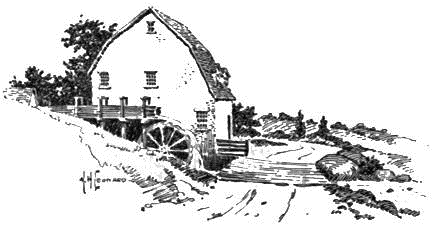
THE LOOM
Have you ever seen a loom? It would not be a wonder if you have not. In these days the average person seldom sees one. Everyone knows in a vague sort of way that clothes and carpets are made of wool or silk or cotton, as the case may be, and that they are woven upon an instrument called a loom. This is about as much as we usually know about the clothes we wear or the carpets we walk upon. We buy these things from the store and that is all there is to it. In the olden times, and not so very long ago either, everybody knew something about weaving, at least every girl and woman knew something of the art, and a loom was as familiar an object in the household then as a sewing machine is now.
Matrons and maidens sat in snow-white caps and in kirtlesScarlet and blue and green, with distaff spinning the goldenFlax for the gossiping loom, whose noisy shuttle within doorsMingled their sounds with the whir of the wheels and the songs of the maidens.This picture of home life in Acadia two hundred years ago would have served as a picture of home life almost everywhere in the civilized world. From the beginning of history until modern times most of the weaving was done by the women in the home.

FIG. 1. – THE FIRST LESSON IN WEAVING.

FIG. 2. – A WIER TRAP OF THE VIRGINIA INDIANS.
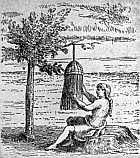
FIG. 3. – PRIMITIVE BASKET MAKING.
The earliest practical weaver on record is the spider and it may be that man learned his first lesson in weaving from this skilled little workman (Fig. 1); or the beautiful nest of the weaver-bird may have given to human beings the first hints in the weaving art. Whoever may have been his teacher, it is certain that man learned how to weave in the earliest stages of existence. It is thought that his first effort in this direction consisted in making cages for animals and wiers (traps) for catching fish (Fig. 2) by interlacing vines or canes or slender boughs. The next step was taken when women began to make baskets and cradles and mats by interlacing long slender strips of wood (Fig. 3).
Basket weaving led to cloth weaving, and this led to the loom. In Figure 4 we see the simplest and oldest form of the loom. It consisted of a single stick (yarn beam) of wood about four feet long. This was the first form of the loom – just a straight stick of wood and nothing more. From the stick the threads which run lengthwise in the cloth were suspended. These threads are known as the warp. The threads which run breadthwise in the cloth are known as the weft, or woof. As the woman's deft fingers pass along with the weft she carries the thread over the first warp thread, under the second, over the third, under the fourth, and so on. Here we have not only the simplest form of the loom but the simplest kind of cloth.
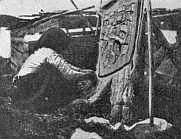
FIG. 4. – THE PRIMITIVE LOOM.
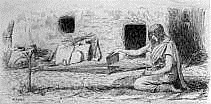
FIG. 5. – THE PUEBLO LOOM.
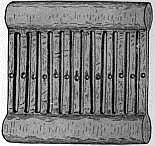
FIG. 6. – THE HEDDLE.
In the loom worked by the Pueblo woman (Fig. 5) a new piece appears. This is the frame through which the threads of the warp pass and which the woman is holding in her right hand. The frame is called a heald, or heddle (Fig. 6). The heddle is of the greatest importance in the construction of the loom and it is well worth while to understand what it does. In the loom operated by the Chilcoot woman (Fig. 4) you noticed that the weaver passed the weft thread above and below the alternate threads of the warp. This required a separate movement for every thread of the warp; if there were a hundred threads a hundred movements were required to pass the weft across once. Now the heddle used by the Pueblo woman separated the fifty warp threads that were to pass above the weft thread from the fifty that were to pass below it, making an opening called, a shed. When the shed was made the weft thread could be passed across at one movement. One movement instead of a hundred! How was this accomplished? Fifty alternate warp threads were passed through the holes in the bars of the heddle frame, one thread through each hole; the other fifty alternate threads passed between the bars of the heddle frame. Now suppose the entire warp of a hundred threads is stretched tight and firm between the woman's body and the yarn beam. With her right hand she raises the heddle and thus lifts the fifty threads which pass through the holes in the bars, while the other fifty threads remain unmoved. This movement makes the passage or shed through which she passes the weft with the left hand. After beating the weft thread close to the cloth either with the fingers or with a sword-like stick, she lowers the heddle with its fifty threads, the other fifty still remain fixed and unmoved. Another shed is formed and the weft is passed through again. Thus with the raising and lowering of the heddle the weft is passed backward and forward and the weaving goes on quite rapidly. If you care to do so you can make a Pueblo loom and can weave a belt on it.



